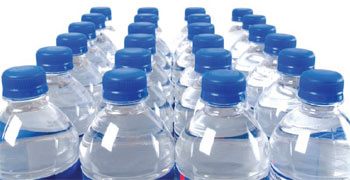 |
 |
 |
|
April 2011
|
The unclear cost of bottled waterBy Christopher Starr
There is a reason why it is so outrageously expensive, as its production is a heavy industry. Even in areas where it comes from public reservoirs with minimal filtering and “mineralization,” the bottles must still be manufactured and filled. Then there is the cost of transporting them, often from one continent to another. And on top of that is the company’s very substantial layer of profit, to say nothing of advertising costs. Every time you pay several of your dollars for a bottle of plain old water – did I mention that it is very abundant, and you can get it for free? – you are pouring them into a very lucrative scam. San Francisco was, I believe, the first major city to stop providing bottled water at all official functions. This made good economic sense, and many others have since followed suit. However, the real cost of bottled water goes far beyond its price. The real cost is not paid in the store but in our environment. Plastic is made from petroleum, and the worldwide manufacture of an estimated 200 billion plastic water bottles per year wastes a huge amount of fossil fuel, while releasing CO2 and toxic gases into the atmosphere. Petroleum is turned into plastic; it is used in running the plant to make the bottles; to run the bottling plant, and in transporting those bottles of water from the factory to the sales outlets. The manufacture and transport of one litre of bottled water consumes an estimated 6.7 litres of water, 0.8 litre of fuel, and emits 0.6 kg of greenhouse gases.
The key to the bottled-water scam is the widespread belief that it is cleaner and safer. In some countries it undoubtedly is. In some others, exactly the opposite is true, as municipal water supplies are held to a higher standard than commercial bottled water. What about Trinidad & Tobago? Is there any good reason either to mistrust WASA-supplied water or trust what comes in bottles? We have the capability, but I am not aware that the necessary tests have been done. If it turns out that water from our faucets, stand pipes and drinking fountains is, in fact, below standard, the solution is not to buy it in the store. Rather, we need to improve our public water supplies. Then there will be no reason to even think of paying good money for a completely unnecessary product that exacts a terrible cost from Mother Earth. -Dr Christopher Starr is a Senior Lecturer in Entomology at the Department of Life Sciences and a member of the Environmental Committee at the St. Augustine Campus. |

 I am often appalled to see what people will pay for bottled water. After all, it’s just plain old H2O, one of the commonest of all substances, which you get for free from a drinking fountain or your home faucet.
I am often appalled to see what people will pay for bottled water. After all, it’s just plain old H2O, one of the commonest of all substances, which you get for free from a drinking fountain or your home faucet. The environmental damage does not stop there. Most plastic bottles, once empty, are simply discarded. Some are refilled for free from water fountains or faucets – smart move – and some are recycled, but not many. You see discarded bottles on our roadsides and beaches, and most eventually make it into the dump, where they will take centuries to break down.
The environmental damage does not stop there. Most plastic bottles, once empty, are simply discarded. Some are refilled for free from water fountains or faucets – smart move – and some are recycled, but not many. You see discarded bottles on our roadsides and beaches, and most eventually make it into the dump, where they will take centuries to break down.